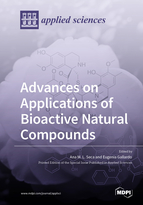Advances on Applications of Bioactive Natural Compounds
A special issue of Applied Sciences (ISSN 2076-3417). This special issue belongs to the section "Applied Biosciences and Bioengineering".
Deadline for manuscript submissions: closed (31 October 2021) | Viewed by 35541
Special Issue Editors
Interests: bioactive natural compounds; secondary metabolites; chromatographic techniques; spectroscopic techniques; natural compounds
Special Issues, Collections and Topics in MDPI journals
2. Pharmaco-Toxicology Laboratory, UBIMedical, University of Beira Interior, Covilhã, Portugal
3. Centro Académico Clínico das Beiras (CACB)—Grupo de Problemas Relacionados com Toxicofilias, Covilhã, Portugal
Interests: toxicology; analytical method development; recreational drugs; natural psychoactive substances; therapeutic drug monitoring; sample preparation; alternative samples; miniaturized extraction procedures
Special Issues, Collections and Topics in MDPI journals
Special Issue Information
Dear Colleagues,
Natural compounds, from terrestrial and marine sources, are the result of an evolutionary process which originated in compounds with great structural diversity, multiple biological activities and miscellaneous applications. A large and very active research field is dedicated to identifying biosynthesized compounds; to improve/develop new methodologies; to produce/reuse natural compounds; to assess their potential; and to understand their mechanism of action. These are the reasons why the Special Issue “Advances on Applications of Bioactive Natural Compounds” has been created.
This Special Issue aims to collect excellent original and review works, focused on the most recent advances related to secondary metabolites’ composition of natural sources, and the proposal of new applications for their constituents, such as therapeutic agents, and cosmetics and food ingredients.
As guest editors, we invite and look forward to receiving your contributions.
Prof. Dr. Ana M. L. Seca
Prof. Dr. Eugenia Gallardo
Guest Editors
Manuscript Submission Information
Manuscripts should be submitted online at www.mdpi.com by registering and logging in to this website. Once you are registered, click here to go to the submission form. Manuscripts can be submitted until the deadline. All submissions that pass pre-check are peer-reviewed. Accepted papers will be published continuously in the journal (as soon as accepted) and will be listed together on the special issue website. Research articles, review articles as well as short communications are invited. For planned papers, a title and short abstract (about 100 words) can be sent to the Editorial Office for announcement on this website.
Submitted manuscripts should not have been published previously, nor be under consideration for publication elsewhere (except conference proceedings papers). All manuscripts are thoroughly refereed through a single-blind peer-review process. A guide for authors and other relevant information for submission of manuscripts is available on the Instructions for Authors page. Applied Sciences is an international peer-reviewed open access semimonthly journal published by MDPI.
Please visit the Instructions for Authors page before submitting a manuscript. The Article Processing Charge (APC) for publication in this open access journal is 2400 CHF (Swiss Francs). Submitted papers should be well formatted and use good English. Authors may use MDPI's English editing service prior to publication or during author revisions.
Keywords
- natural compound
- applications
- bioactive
- medicine
- health
- cosmetic
- food







